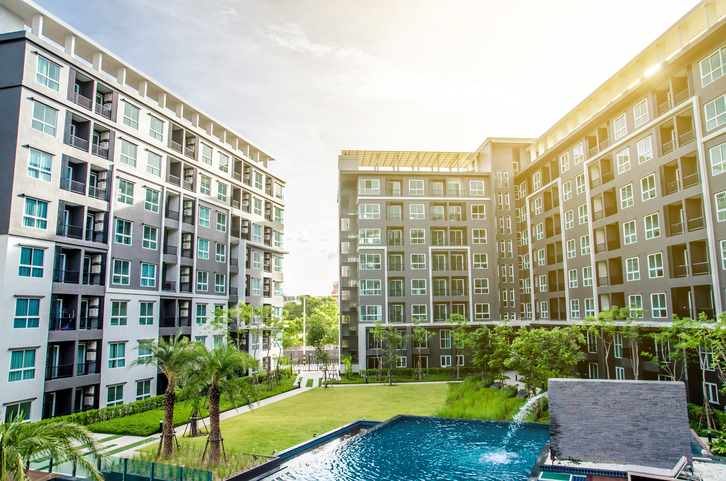How to Buy Apartments With No Money Down

I do lots of different types of real estate, but my main investment moneymaker is apartments.
Yet, in my travels around the U.S., I constantly hear the same old objection:
“I love the idea of apartment cash flow, but I absolutely hate the idea of tenants!”
Just between you and me, I like to hear people say that because it keeps the competition down.
If everyone knew how easy it is to hire a good building manager and get regular passive cash flow – but no calls – from tenants, it would be a lot harder for me to do deals.
Meanwhile, it’s been even easier for me recently because of the high-profile media coverage of the skyrocketing foreclosure rate and the sub-prime mortgage meltdown.
You see, the current housing market has an upside that few people are talking about: the fact that that there’s rarely been a better time to buy and own multi-family properties.
Why? Because even though the woes of the residential housing market are making it more difficult for the average person to get a home loan, people still have to live somewhere. As the owner of more than 3,100 rental units, I can tell you that a tight credit market is very good for my business.
So ignore the hogwash about real estate investing being “dead.” We’re only getting to the good part, where the dabblers and wannabes move on to other activities, leaving less competition for the rest of us.
And let me tell you a secret that most would-be investors don’t know: You can reap profits from apartments even if you don’t have two pennies to rub together for a down payment.
Why People Who Can’t Get a Home Loan Can Still Make Big Rental Profits
There are many good lenders around the country that will fund your multi-family deal. The best part is that they will look at your deal first, before they look at you.
The lending institution’s first priority is to make sure your property will have cash flow after all expenses. Then they’ll take a look at the “debt service ratio.” This is simply the number of times your property’s gross income will cover its gross expenses. Lenders want to see a debt service ratio of 1.2 or higher. A number less than 1 means that your gross income from the property won’t cover your gross debt. That’s not good, because you’ll be losing money every month.
Here’s the best part of the calculation: The bank is going to take 75 percent of the property’s net cash flow and add that to YOUR income to help you qualify for the loan. In a sense, the bigger the property you buy, the easier it is for you to qualify.
If you don’t have a down payment, you still have the option of using a hard-money lender instead of a bank. Most hard-money lenders will loan you 100 percent of the loan amount, as long as you buy the property below 65 percent of its after-repaired value.
That may sound difficult at first, but think about what it means: 65 percent of after-repaired value. Say you buy a property for $650,000 that has low rents or low occupancy. Once you increase the rents or occupancy, that property may be worth $1,000,000 or more. In that case, you’ve just bought your first million-dollar property with no money down.
SUGGESTED: Seven Years to Seven Figures
With so many motivated sellers in the market today, you can also combine owner financing with third-party financing and, if need be, with equity investors… to end up with your first seven-figure deal with no money down from you.
If numbers that large make you nervous, take a zero off the end of each one in the example above. Start where you are comfortable and work your way up.
This may all sound like nice theory to you, but I assure you it works.
When I started investing in apartment buildings, I didn’t have a job.
My previous business (a landscaping company) had failed, and I had a whopping $800 in my bank account.
SUGGESTED: Starting Young – The Miracle of Compound Interest
I bought three three-family properties using the first technique I just described. They all needed repairs. I bought them cheap enough (with a 65 percent loan to after-repaired value) that I didn’t have to come out of pocket for the purchase or for any of the rehab money. A hard-money lender covered it all.
The properties cash flowed properly, so I covered all of my debt with my income. (Hard-money debt is usually 15 percent interest or more.) With the income from all three properties, I was able to qualify for long-term financing from a local bank.
Then I was off and running. What a country!
The same strategy can work for just about anyone. For example, one of my students, John Yu, goes to college full-time. I recently received a message from him saying that this method has allowed him to make more than $50,000 since last January. And he’s just one of the successful investors I know who are cashing in on apartments in today’s market.
Sure, you should invest carefully. Sure, there are markets on the downturn. But many of these are providing great opportunities – even for no-money-down purchases. And if you know where to look, and how to invest, you can even find solid opportunities right in your own backyard.